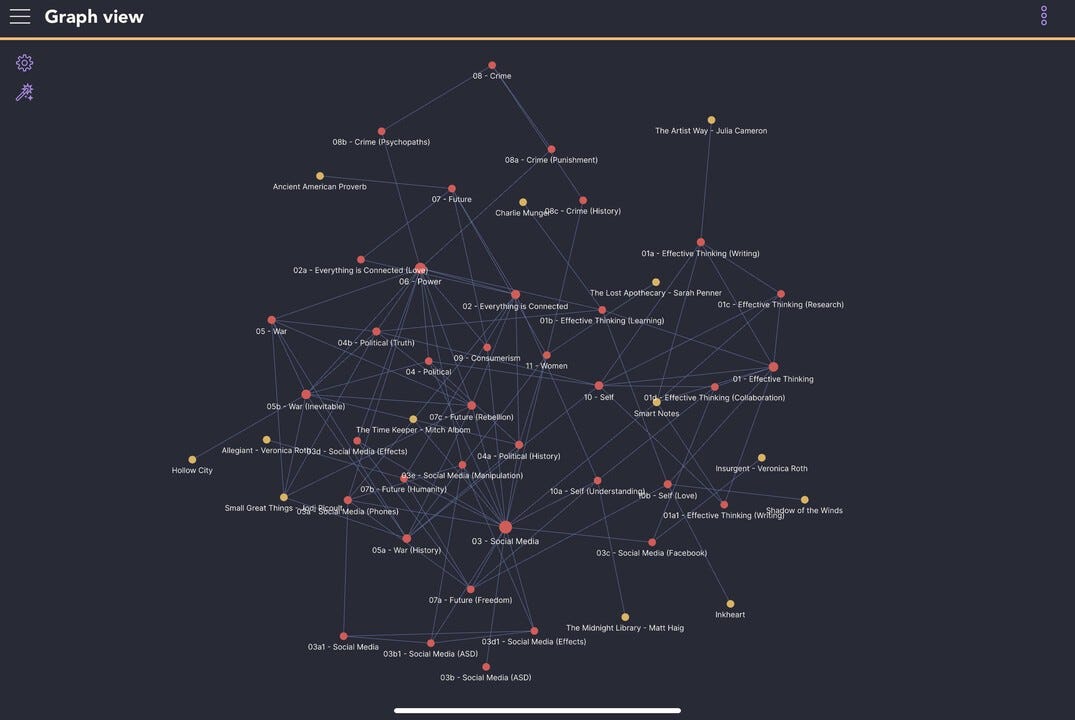How to Easily Maximise Your Productivity with a Second Brain
Using Obsidian and Kettelkasten you can have an ideas avalanche
I have been down some pretty dramatic rabbit holes throughout my time as a writer. For example, writing true crime, I often start with one murderer to find many others connected and end up with even more to write about.
However, I have never been down a rabbit hole like the one I went down this week. Not that it was all bad, as this rabbit hole has helped me streamline my idea manufacturing and how I keep notes.
The system I am talking about is Zettelkasten.
What is Zettelkasten
Two weeks ago, after watching a webinar with Todd Bison, I thought it was about time I checked out what he had written on Medium. He had published an article on his favourite books. I love articles on books, so I had a read.
One of the books he recommended was Smart Notes by Ahrens Sonke. So the rabbit hole started by reading this book which explained Zettelkasten. Zettelkasten is the German word for slip-box. It means storing your ideas and research in a system of notes.
Zettelkasten is the system of writing three types of notes. The first is fleeting notes which are those random thoughts that come into our heads. Those that, if we do not grab, disappear for good.
The second types are literature notes, quotes and interesting facts you read. Like me, if you are an avid reader and note taker; this is where all this information is put. Ever remembered the perfect quote and then did not remember where you heard it? This stops that.
The last notes are permanent notes. This is where you take all those random fleeting and literature notes and start thinking more profoundly about them. They become a permanent note and can be used as the start of articles.
If you are interested in this, there are many YouTube videos on the subject. This took me to my second rabbit hole.
Implementing Zettelkasten
I could not understand the book. It was not that well written; five hundred words were used when one hundred would have done.
What the book did, though, was piqued my interest in the system enough for me to research further, which is where the brilliant YouTubers came in.
Maybe I am a visual learner, so it is easier for me to learn using this medium. However, the part of the system that completely confused me was how you then reference these permanent notes to make meaningful connections between your ideas.
The consistent advice for using this system seemed to be to use technology. A program that helped you make the connections between the ideas without using the complicated referencing system.
The program that was most recommended was a program called Obsidian. And what a recommendation that is.
Obsidian
This program is a game changer for all writers. It links the ideas you have. Of course, there are other programs out there that do this, but the joy of Obsidian is that it is free.
Don’t tell the developers, but I would quickly pay three figures for it, having used it for two weeks.
This consisted of a new rabbit hole; this time, I learned how to use Obsidian; again, YouTube was my friend. There are so many videos; the interactive nature of seeing how to do things whilst they are talked about works well with learning new platforms.
The fun part of the program is that when the program links the notes, it will then give you a map of your brain. So, for example, the picture at the top of this article is my brain.
The Ultimate Test
To test the actual productiveness of Obsidian, I have decided to set it the ultimate challenge. I have, over the years, been obsessed with Jack the Ripper. I have folders full of research but have always struggled to connect the dots.
By putting the information in over the next couple of months, I will see if connections establish that I have not seen before.
The process will take a while; as you can imagine, there is much to transfer, but I am sure this will work well for me.
Writers’ to-do list
If you are a writer with many different notebooks full of a chaotic mass of notes, I would strongly suggest that you look at the Zettelkasten method of taking notes.
I have introduced it briefly here. I am not going into more detail; as Einstein said, if you can’t explain something simply enough, you don’t understand it, and I am at that stage.
Some brilliant videos and resources can teach you all about this. I would also advise looking at some videos on Obsidian and seeing if this is how your brain works. It is a brilliant program and has fast become my second brain.
Every writer should have a second brain.


